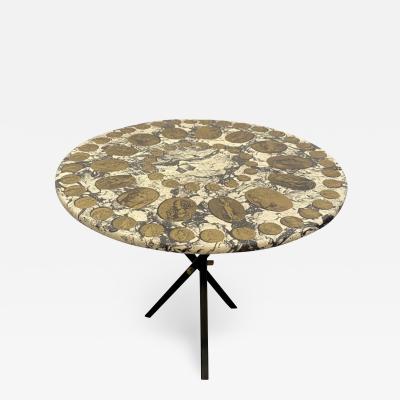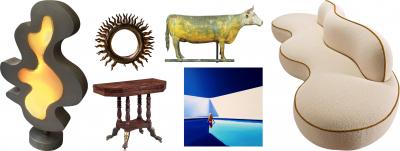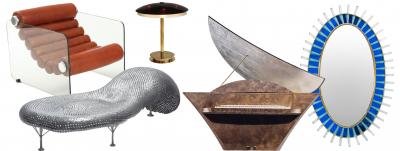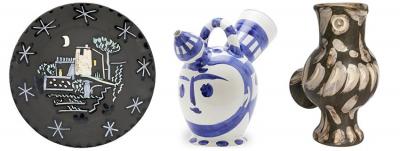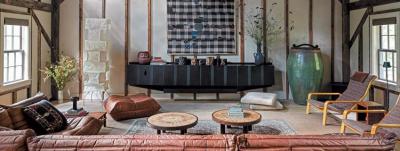The Diva of Design: Robertaebasta and Roberta Tagliavini’s Five-Decade Love Affair with Design
 |
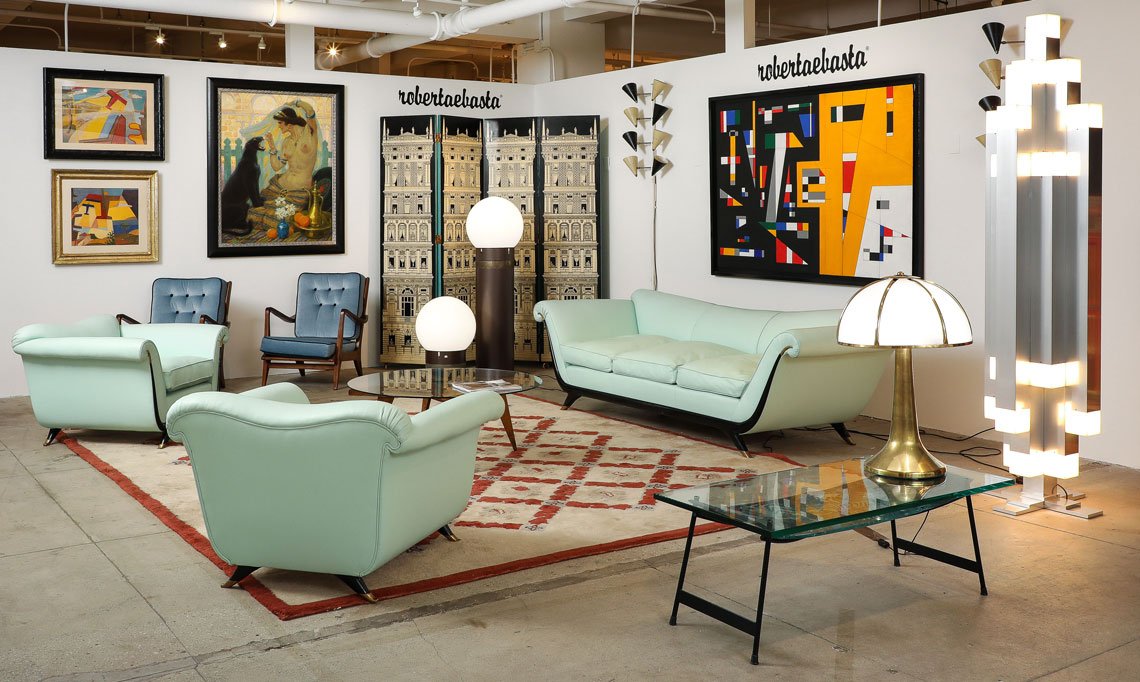 |
| Robertaebasta's booth at The Gallery at 200 LEX: a 1940s rug by Jules Leleu; pair of Gio Ponti walnut armchairs circa 1950s; a pair of 1930s Art Deco armchairs and three-seater sofa in light blue leather attributed to Guglielmo Ulrich; 1960s coffee table by Duilio Barnabé for Fontana Arte; 'Fungo' table lamp, Gabriella Crespi, 1970s; artwork by (L to R) Giulio d'Anna, Ludovic Alleaume and Roberto Crippa, 'Mezzorocolo' table lamp and 'Orocolo' floor lamp by Gae Aulenti for Artemide, 1969; Stilnovo 1950s black and white wall lights; and a 1970s rare 'Momo' New Lamp floor lamp by Mario Vento. Photo courtesy The Gallery at 200 LEX. |
Robertaebasta and Roberta Tagliavini’s Five-Decade Love Affair with Design
all photos courtesy Robertaebasta unless otherwise noted
 | |
Mattia Martinelli and Roberta Tagliavini |
It was 1967 and the world was in turmoil, with racial unrest across America, the outbreak of the Six Days War in Israel, while, in Italy, political terrorism, protests, and social upheaval erupted and would continue for more than a decade. Nevertheless, an undaunted Roberta Tagliavini, a force of nature in the making, opened a little showroom in Milan where she bought and sold antiques, back then, mostly tables in the 18th-century French Provincial country house style, reflecting the prevailing tastes of her Italian clients.
Tagliavini was selling antiques but her true, secret passion was modern design, especially from her native Italy, then experiencing an unprecedented design boom in the post-World War II period. But no one was interested in modernism. “In the 1960s few people understood modern design,” Tagliavini says, sitting in one of her five Milanese galleries with her son, Mattia Martinelli, who since 1994 has worked alongside her in the trade. “When I displayed modern things people would come up to me in the store and ask me why I was selling used office furniture!”
 |
| A spectacularly animated 1980s leather sofa by Poltromec Italia in one of Robertaebasta's five Milan galleries. |
 |
| 'Joe' Lounge Chair by De Pas, D’Urbino, Lomazzi for Poltronova, 1970s, Surrealist 'Magritta' chair by Roberto Matta, in the form of an upended bowler hat and green apple cushion, based on René Magritte's famous work The Son of Man, and a wall of framed butterfly specimens. |
Today, Tagliavini is the doyenne of Italian design dealers, and her brand, Robertaebasta, is one of the best-known and trusted design galleries in the world, with showrooms in Milan as well as in London (spread over four floors in a building on Pimlico Road in Chelsea), and now a new gallery space in New York at The Gallery @ 200 Lex in the New York Design Center. She is a celebrity in Italy because of her pioneering gallery and her passionate, larger-than-life-personality, joyfully depicted in her starring role as the “volcanic” Brera dealer in the hit reality television series, The Merchant of Brera, which opens the doors to the world of Robertaebasta, and her position as an expert on Cash or Trash, an Italian version of the Antiques Roadshow.
Tagliavini’s celebrity has also unexpectedly helped the gallery to source new inventory. “We buy mostly from private homes and individuals who come to offer us the items they have,” Martinelli says. The gallery receives around 400 emails a day from people who want to sell. “The popularity of my mother is very important for this. But the nice thing is her popularity with young people in Italy. So many of them come to visit my mother, come to visit the gallery, and say to her, ‘You are very interesting, we want to do what you do.’ Television opened a window for a lot of people.”
 |  | |
| Left: Alessandro Mendini's pointillist painted 'Poltrona di Proust' easy chair, designed 1978, produced by Cappellini, Milan. Right: A booth shot at Masterpiece London 2020. | ||
Tagliavini has not had any formal training in design or history but has since become an undisputed reference for the decorative arts and design of the 20th century in Italy. Martinelli attributes this accolade to her passion for the material. “She is always looking, learning, studying, and always with a book in her hands to understand. I am the same. This is the kind of school you make in the shop,” he says. Then there is all of the buying. Tagliavini buys something every day, sometimes several things a day. Minutes before we spoke she concluded the purchase of a vintage Stilnovo lamp for the gallery — just one of three things she bought that day. “I buy everywhere, at a fair, online, in a gallery or shop, or even in street markets,” she says.
“Sometimes I think we have so many galleries just so we have somewhere to put everything, all these things Roberta buys,” says Martinelli, himself an expert in 20th-century decorative arts and an interior designer. They have more than 8,000 pieces of furniture, art, and decorative art listed on their website alone and many thousands more in storage. The gallery specializes in historical Italian design, from the 1950s through the 1980s, up until Memphis (1980–1987). They also buy and sell pieces by the great names of European and American design, from Max Ingrand and Paul Evans to Roberto Rida and Zaha Hadid.
 |
| Another view inside the Milan gallery. |
“Italy for us embodies true and pure design,” Martinelli says. “The masters here have seamlessly integrated aesthetics with functionality, epitomizing the essence of design, in my opinion.” Gio Ponti, without a doubt, is the designer Martinelli says he loves the most and likes to live with in his home. “He was such an eclectic genius capable of creating everything from furniture to buildings and then from cars to ceramics and motorcycles, all with rationality and style,” he explains.
French design provided Tagliavini’s first real foray into modernism — specifically Art Nouveau and Art Deco which she encountered as a revelation while traveling to Paris as a young design dealer. She was the first dealer to introduce Art Nouveau and Art Deco into Italy. Also, she began to market works in the Liberty Style (1890–1914), a variant of Art Nouveau characterized by ornate, sinuously-shaped furniture inspired by nature. She was also the first to introduce Tiffany lamps to Italy after seeing them in New York and purchasing over 20 from Macklowe Gallery, a well-known Tiffany dealer.
 |
| Art Deco three-seater sofa attributed to Guglielmo Ulrich, circa 1930s. Available from Robertaebasta at The Gallery at 200 Lex. |
 |  | |
| Left: Rare Piero Fornasetti Pompeiana four-panel screen, circa 1951. Right: Gabriella Crespi Fungo table lamp, circa 1970s. Both available from Robertaebasta at The Gallery at 200 Lex. | ||
 |
| Roberto Crippa, Composizione geometrica, 1950. Signed on the reverse, R. Crippa. Available from Robertaebasta at The Gallery at 200 Lex. |
In the 1980s the economic and political situation had improved and Tagliavini increasingly sought to make connections with new clients both at home and abroad through art fairs — she even participated in one of the first editions of the New York Armory Show. Her first big client was a young Gianni Versace. “He was not famous back then,” Tagliavini says, “he was just starting his business.”
Versace and his sister Donatella were but the first of a stream of famous and wealthy people from the worlds of fashion, film, television, music, and politics who visited her gallery and became her clients. Giorgio Armani, Roberto Cavalli, and the team of Dolce and Gabbana are frequent visitors, as was the late Italian prime minister Silvio Berlusconi, along with a slew of wealthy European bankers and industrialists. Actress Cate Blanchett and film directors the Coen brothers have visited the gallery as well as Cyndi Lauper, who in July, walked into their Milan showroom and bought a variety of pieces.
 |
| Vintage 1970s 'Artona' dining table and 'Africa' chairs by Afra & Tobia Scarpa. |
 |
| An exhibition booth shot featuring 'Elettra' armchairs, 1953 by Arflex. |
 |
| A booth shot from the Winter Show with a pair of Marzio Cecchi 'Balestra' lounge chairs and a Piero Fornasetti screen. |
Martinelli attributes the longevity and success of the gallery entirely to his mother’s eclectic and unfailing good eye. “Every day, several times a day, I argue with her! But the truth is she makes few mistakes,” he says, pointing out that her insatiable curiosity “for everything” has served them well as a business strategy. “Roberta has a forward-looking approach to emerging trends in design. She strives to be avant-garde and always at the forefront of innovation and style. We continuously explore and research beyond current style to anticipate and understand what lies ahead in the design and interior world.”
 | |
| Roberta and Mattia unpacking a shipment of recent acquisitions. |
So, what trends do they see emerging in interiors in Europe or America and in design today? “The world of home furnishings is experiencing a completely thrilling shift towards creating more of a statement, or a ‘Wow’ effect in furniture and objects,” Martinelli says. “In the design market, there’s a buzz, and you can feel it.” Martinelli is also growing, expanding the integration of artwork into their interiors, which they have always done as design dealers. “Art plays a crucial role in our work. It’s part of an interior scheme, but it is also satisfying to provide clients with valuable pieces that over time, will appreciate in value.” They recently sold two bronze eggs by Lucio Fontana, sculptures by Manolo Valdés, and paintings by the Korean origami artist Chun Kwang Young.
The shift online has also impacted the business. “The internet changed the whole approach to selling and buying: even if you don’t sell by the web you have the contact,” Martinelli says. “That’s why sites like Incollect are essential in the art and design market today, as this is how we connect with the whole world.” Today 90% of the new gallery contacts come from the web, Martinelli reveals. So why then do they still have so many physical locations? “So the client knows we are in one place and for client relations if there are problems — they can find you, connect,” he explains. “Also, If you are in a nice part of town more people can see you. That’s good for our branding. Besides, everybody always wants to see my mother.”















